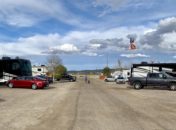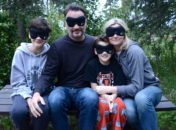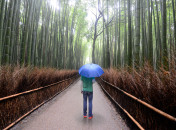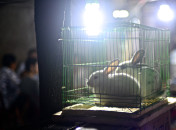Leaving the town of Split in broad daylight was a lot easier then entering it in the dark. We decided to skip seeing Diocletian’s Palace as most of the reviews compared its built-out atmosphere to an amusement park, and instead prioritized jumping the border into Bosnia-Herzegovina (BiH) to visit the city of Mostar and its famous old town and bridge.
Добро пожаловать в кириллических дорожных знаков
We were a bit nervous as this was the first time we’d driven across a border alone (i.e., not inside a bus, train or plane). Not to mention we couldn’t speak the language. And, uh, the road signs were in Cyrillic (кириллица), and once we crossed the border none of the roads were recognized by our GPS so we were flying blind. Many of the tumbledown villages we passed were still scarred from the Homeland War back in the 90s. This was by far the poorest region we’d visited on our travels, and the grim surroundings became much more so as low black clouds brought a steady rain to the dirt roads. The deeper we penetrated into the country, the more I had to play “speed trap.” The local polijica are pretty notorious for revenue-generation through ever-changing speed zones. The deep canyons, curvy road and overhanging trees made seeing the signs a challenge, a fact that was fully exploited by the local officers using speed guns and paddles used to wave over drivers.
Mostar (Мостар) is widely regarded as the cultural capital of BiH, and its picturesque Old Bridge – originally built by the Ottomans in the 16th Century – is also its biggest tourist draw. The first thing we noticed in approaching the city was the beautiful minarets and domes of the town’s mosques (Mostar is 40 percent Muslim). Much of the city still shows signs of the War of Croatian Independence. Bullet holes pock the stucco sides of the schools and homes, and entire blocks are demarked by a solitary wall and blackened piles of stones. Trees and wildflowers poke their leafy stalks out of roofless structures everywhere.
We tramped along the main tourist path of Kujundziluk, a knobby street rebuilt from smooth, rounded river rocks rather than true cobblestones. There we found lunch at a restaurant and I tried the Cevapi, which many consider to be the national dish of Bosnia, but abandoned it after two bites. Horrible! Although the dish is definitely one for serious carnivores, I believe the 11 little beef sausages I was served had been sitting in the bottom of a stainless steel warmer for hours. I’ll try it again at a better restaurant should we find ourselves in the Balkans again.
STARI MOST
A relatively short bridge over a narrow river, Stari Most is considered the best example of Isalmic architecture in the Balkins, and is certainly one of the most beautiful bridges we’ve seen. Built in 1566, it stood for 427 years until it was destroyed during the war. BiH rebuilt and reopened the bridge in 2004. At mid-span, Stari Most is 20 meters above the clear, icy waters of the Neretva. We crossed over and flowed amidst the schools of tourists through the bazaar-like atmosphere of the village, with shop owners hustling visitors and sandwich boards of specials placed so that pedestrians are steered near restaurants doors.
Upon our return crossing, a short-gentleman in nothing but a black Speedo elbowed passed us rather brusquely, a crowd gathering at his heels. The rain had turned to a cool mist as this man calmly climbed onto the top wall of the bridge, poured a bottle of cold water on his face; and with furrowed intensity shadowing his brow – leapt. We couldn’t believe it. Almost 70 feet and into unlit and unsprayed water he fell – his body rigid and controlled so that he pierced the water perfectly. In seconds he buoyed to the surface as tourists cheered, whistled and snapped photos. We later learned that the unnamed hero collects money before the jump and earns around €55 for each plunge.
On our slow walk back to the car, the call to afternoon prayers (Asr) resonated through the echoing streets.
PEARL OF THE ADRIATIC
Dubrovnik was luminescent, shining pink as the sun settled into a bed of fog over the Adriatic. Although none of us had ever set foot within its protective walls, it felt like we were arriving home.
We hoped to find our apartment, drop our gear, grab dinner and hit the sack early. Fortunately, the apartment was spacious and lovely and our host Dubrovka was wonderful. As we were unpacking, she arrived with a tray of fresh juice, cookies and walnut rakija homemade by her mother. It was all tasty to our tired and thirsty crew, and the rakija (a fruit brandy of around 40% ABV) soothed nerves jangled by a day of driving and touring. It was a ten-minute walk down (and we mean down – 185 long, shallow steps) to the Old Town, where Angela had found a Mexican restaurant for dinner. I know, I know. Mexican restaurant? In Dubrovnik? We thought the same thing, but we’d been in Europe for two months. Two months where the creed of spice was represented by a pair of token members – salt and pepper. Pale, dusty pepper. We needed something with kick.
It is impossible to describe how stunning was this ancient town illuminated at night. Just inside its massive gate, an alley intersected the main thoroughfare and I saw a guy sitting on a bench wearing a sombrero. “Do you know where Mex Cantina Bona Fide is?” I asked. He smiled and walked us through the maze directly to the restaurant, gave us our menus and went back to his bench. It wouldn’t qualify as true Mexican food, but it worked for us. Tortilla chips, cheese and jalapenos work anywhere.
After the meal, we walked to the harbor and returned to stand among a surprisingly active horde of tourists bouncing around the town square. Across from the bell tower an owl stalked, frozen and observant from the bulwark along the top of the wall. We too were frozen, wondering whether it was real and if so, what the owl was watching. With one flap of its broad wings, the owl covered 15 meters and snatched a bat out of the air.
Our first full day in Dubrovnik was as low-key as it gets. We spent 45 minutes in the grocery picking up provisions (most of the time trying to decipher the language). Then the afternoon was spent on school for the boys, while I “donated” four hours to learning about patience (returning the rental car to the airport). Fortunately, the weather was spectacular – sunny, cloudless skies and cool ocean breezes.
The sun was low in the sky when we entered Old Town Dubrovnik through the Gate of Pila and climbed the steep travertine steps to the ancient wall. The complete loop is a relatively short stroll and offers incredible views of the roofs, clotheslines, private terraces and hidden gardens inside, and of the Adriatic, the harbor and the hillside outside. Although the walk is rather expensive at nearly $50, and despite websites that tell you where to scale a fence and walk it for free, our donation for the upkeep was worth it. It was yet another stunning Croatian experience, and we were the last four people on the wall as it closed. We sat in the open plaza staring up into the sky – now indigo and crimson and coral, rapt like monks before the windows in Sainte-Chapelle.
ŽELJKO FRANIĆ – IT’S PRONOUNCED EXACTLY HOW IT’S SPELLED
I saw the van first, wedged in the narrow, stone-walled alley outside our apartment. He was early. That was just fine for us as we were excited to have proper guide for a day of touring Montenegro. He was all smiles when we were introduced, though we struggled to pronounce his name. I knew what kind of day it was going to be when I asked how he spelled it. “Spelling won’t help to know how to say it,” he chuckled and herded us toward the van’s open doors. Inside, he handed me a business card and said, “see.” Željko was right, unless of course I already knew Croatian.
It was a private tour, just our family in a large van, and Željko invited me to sit with him up front. Partially influenced by sites that Angela had researched, he had a preplanned loop that would take us to several spots in Montenegro around the winding Bay of Kotor. We rode a boat out to Our Lady of the Rocks (Gospa od Škrpjela) on which its first church was built in 1452. According to legend, the island formed as sailors passing by on their journeys out to sea would throw a rock into the water and say a prayer. We learned that each evening, the townspeople used to drape a long chain across the strait to prevent pirate raiding parties from entering in the dark of night. Then we circled around to the town of Kotor (founded prior to 200 B.C.) for a stroll and lunch. The town was beautiful, over-touristy and crowded. It is a hotspot destination for cruise ships, one of which was unloading as we arrived. Our lunch was among the worst of the trip but walking the town was lovely. We then visited Porto Montenegro, a luxury yacht marina and ultra high-end shopping and residential complex that appeared to be about 75% built out. Given how lean we’d been living for the past several months, it felt like another world, with crews cleaning and prepping several 50-meter plus private yachts. We wrapped the day with a comparably modest ferry ride across the bay and drive back over the mountains into Dubrovnik.
The highlight for us was the opportunity to listen and learn, and perhaps more importantly, to meet Željko. A former ship captain who had been all over the world and a business owner who lived through the decimation of his country, he was a fascinating person. Tall and rangy with a head of thick white hair and a mustache, Željko knew people everywhere we went – border agents, shop owners, even passing motorists. In the midst of stories, he’d pause to waive back at someone, which would prompt another story about that person or the village they were from. Željko toggled from the intricacies of the Homeland War to how U.S.-led sanctions are hurting the already poor orange-growers in Bosnia-Herzegovina. Then, he’d point out a café that served great coffee or recommend a great beach for Asher, or humorously share that Croatians call speed bumps “spavanje policija,” or “sleeping police.” When we left Croatia, we left a new friend.
Croatia is a beautiful place and one of the hottest travel destinations in the world. But it was the people we met along the way – Ljiljiana, Anna, Željko, Dubrovka and her family – that made the experience unforgettable. We arranged for Željko to deliver us to the airport at the end of our stay. “Send me an email and let me know how your trip went,” he said in farewell.
CLICK ANY PHOTO TO OPEN THE GALLERY.















































































